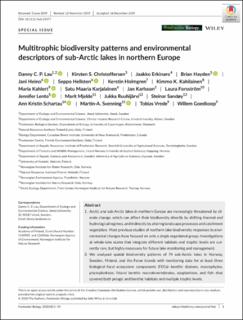| dc.description.abstract | 1. Arctic and sub-Arctic lakes in northern Europe are increasingly threatened by climate change, which can affect their biodiversity directly by shifting thermal and hydrological regimes, and indirectly by altering landscape processes and catchment vegetation. Most previous studies of northern lake biodiversity responses to environmental changes have focused on only a single organismal group. Investigations at whole-lake scales that integrate different habitats and trophic levels are currently rare, but highly necessary for future lake monitoring and management. 2. We analysed spatial biodiversity patterns of 74 sub-Arctic lakes in Norway, Sweden, Finland, and the Faroe Islands with monitoring data for at least three biological focal ecosystem components (FECs)—benthic diatoms, macrophytes, phytoplankton, littoral benthic macroinvertebrates, zooplankton, and fish—that covered both pelagic and benthic habitats and multiple trophic levels. 3. We calculated the richnessrelative (i.e. taxon richness of a FEC in the lake divided by the total richness of that FEC in all 74 lakes) and the biodiversity metrics (i.e. taxon richness, inverse Simpson index (diversity), and taxon evenness) of individual FECs using presence–absence and abundance data, respectively. We then investigated whether the FEC richnessrelative and biodiversity metrics were correlated with lake abiotic and geospatial variables. We hypothesised that (1) individual FECs would be more diverse in a warmer and wetter climate (e.g. at lower latitudes and/or elevations), and in hydrobasins with greater forest cover that could enhance the supply of terrestrial organic matter and nutrients that stimulated lake productivity; and (2) patterns in FEC responses would be coupled among trophic levels. 4. Results from redundancy analyses showed that the richnessrelative of phytoplankton, macrophytes, and fish decreased, but those of the intermediate trophic levels (i.e. macroinvertebrates and zooplankton) increased with decreasing latitude and/ or elevation. Fish richnessrelative and diversity increased with increasing temporal variation in climate (temperature and/or precipitation), ambient nutrient concentrations (e.g. total nitrogen) in lakes, and woody vegetation (e.g. taiga forest) cover in hydrobasins, whereas taxon richness of macroinvertebrates and zooplankton decreased with increasing temporal variation in climate. 5. The similar patterns detected for richnessrelative of fish, macrophytes, and phytoplankton could be caused by similar responses to the environmental descriptors, and/or the beneficial effects of macrophytes as habitat structure. By creating habitat, macrophytes may increase fish diversity and production, which in turn may promote higher densities and probably more diverse assemblages of phytoplankton through trophic cascades. Lakes with greater fish richnessrelative tended to have greater average richnessrelative among FECs, suggesting that fish are a potential indicator for overall lake biodiversity. 6. Overall, the biodiversity patterns observed along the environmental gradients were trophic-level specific, indicating that an integrated food-web perspective may lead to a more holistic understanding of ecosystem biodiversity in future monitoring and management of high-latitude lakes. In future, monitoring should also focus on collecting more abundance data for fish and lower trophic levels in both benthic and pelagic habitats. This may require more concentrated sampling effort on fewer lakes at smaller spatial scales, while continuing to sample lakes distributed along environmental gradients. | en_US |

